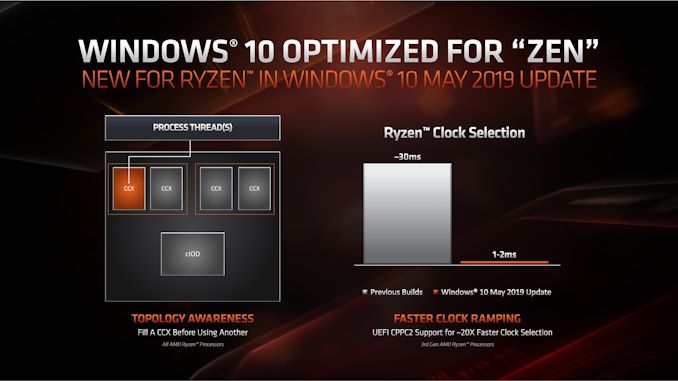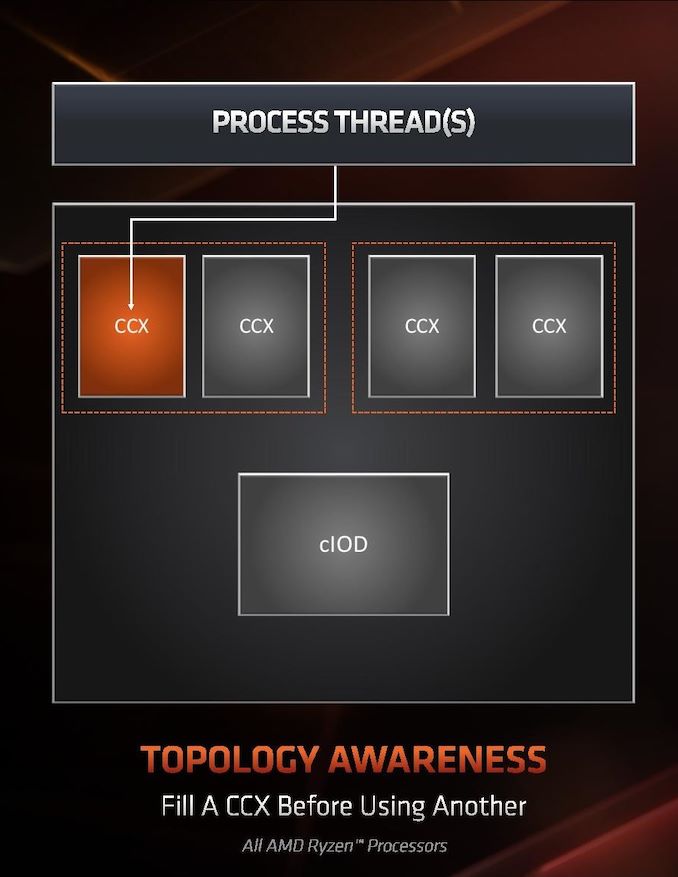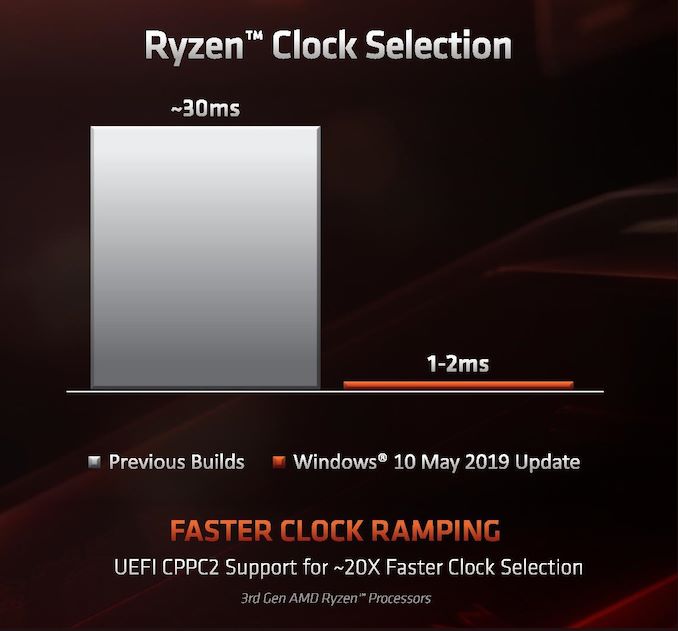AMD Zen 2 Microarchitecture Analysis: Ryzen 3000 and EPYC Rome
by Dr. Ian Cutress on June 10, 2019 7:22 PM EST- Posted in
- CPUs
- AMD
- Ryzen
- EPYC
- Infinity Fabric
- PCIe 4.0
- Zen 2
- Rome
- Ryzen 3000
- Ryzen 3rd Gen
Windows Optimizations
One of the key points that have been a pain in the side of non-Intel processors using Windows has been the optimizations and scheduler arrangements in the operating system. We’ve seen in the past how Windows has not been kind to non-Intel microarchitecture layouts, such as AMD’s previous module design in Bulldozer, the Qualcomm hybrid CPU strategy with Windows on Snapdragon, and more recently with multi-die arrangements on Threadripper that introduce different memory latency domains into consumer computing.
Obviously AMD has a close relationship with Microsoft when it comes down to identifying a non-regular core topology with a processor, and the two companies work towards ensuring that thread and memory assignments, absent of program driven direction, attempt to make the most out of the system. With the May 10th update to Windows, some additional features have been put in place to get the most out of the upcoming Zen 2 microarchitecture and Ryzen 3000 silicon layouts.
The optimizations come on two fronts, both of which are reasonably easy to explain.
Thread Grouping
The first is thread allocation. When a processor has different ‘groups’ of CPU cores, there are different ways in which threads are allocated, all of which have pros and cons. The two extremes for thread allocation come down to thread grouping and thread expansion.
Thread grouping is where as new threads are spawned, they will be allocated onto cores directly next to cores that already have threads. This keeps the threads close together, for thread-to-thread communication, however it can create regions of high power density, especially when there are many cores on the processor but only a couple are active.
Thread expansion is where cores are placed as far away from each other as possible. In AMD’s case, this would mean a second thread spawning on a different chiplet, or a different core complex/CCX, as far away as possible. This allows the CPU to maintain high performance by not having regions of high power density, typically providing the best turbo performance across multiple threads.
The danger of thread expansion is when a program spawns two threads that end up on different sides of the CPU. In Threadripper, this could even mean that the second thread was on a part of the CPU that had a long memory latency, causing an imbalance in the potential performance between the two threads, even though the cores those threads were on would have been at the higher turbo frequency.
Because of how modern software, and in particular video games, are now spawning multiple threads rather than relying on a single thread, and those threads need to talk to each other, AMD is moving from a hybrid thread expansion technique to a thread grouping technique. This means that one CCX will fill up with threads before another CCX is even accessed. AMD believes that despite the potential for high power density within a chiplet, while the other might be inactive, is still worth it for overall performance.
For Matisse, this should afford a nice improvement for limited thread scenarios, and on the face of the technology, gaming. It will be interesting to see how much of an affect this has on the upcoming EPYC Rome CPUs or future Threadripper designs. The single benchmark AMD provided in its explanation was Rocket League at 1080p Low, which reported a +15% frame rate gain.
Clock Ramping
For any of our users familiar with our Skylake microarchitecture deep dive, you may remember that Intel introduced a new feature called Speed Shift that enabled the processor to adjust between different P-states more freely, as well as ramping from idle to load very quickly – from 100 ms to 40ms in the first version in Skylake, then down to 15 ms with Kaby Lake. It did this by handing P-state control back from the OS to the processor, which reacted based on instruction throughput and request. With Zen 2, AMD is now enabling the same feature.
AMD already has sufficiently more granularity in its frequency adjustments over Intel, allowing for 25 MHz differences rather than 100 MHz differences, however enabling a faster ramp-to-load frequency jump is going to help AMD when it comes to very burst-driven workloads, such as WebXPRT (Intel’s favorite for this sort of demonstration). According to AMD, the way that this has been implemented with Zen 2 will require BIOS updates as well as moving to the Windows May 10th update, but it will reduce frequency ramping from ~30 milliseconds on Zen to ~1-2 milliseconds on Zen 2. It should be noted that this is much faster than the numbers Intel tends to provide.
The technical name for AMD’s implementation involves CPPC2, or Collaborative Power Performance Control 2, and AMD’s metrics state that this can increase burst workloads and also application loading. AMD cites a +6% performance gain in application launch times using PCMark10’s app launch sub-test.
Hardened Security for Zen 2
Another aspect to Zen 2 is AMD’s approach to heightened security requirements of modern processors. As has been reported, a good number of the recent array of side channel exploits do not affect AMD processors, primarily because of how AMD manages its TLB buffers that have always required additional security checks before most of this became an issue. Nonetheless, for the issues to which AMD is vulnerable, it has implemented a full hardware-based security platform for them.
The change here comes for the Speculative Store Bypass, known as Spectre v4, which AMD now has additional hardware to work in conjunction with the OS or virtual memory managers such as hypervisors in order to control. AMD doesn’t expect any performance change from these updates. Newer issues such as Foreshadow and Zombieload do not affect AMD processors.














216 Comments
View All Comments
scineram - Wednesday, June 12, 2019 - link
No.Xyler94 - Thursday, June 13, 2019 - link
YesXyler94 - Thursday, June 13, 2019 - link
If he meant 2700x, of course. Darn misreading :Pnevcairiel - Monday, June 10, 2019 - link
A quick note. AVX2 is actually primarily Integer. AVX1 (or just AVX) is 256-bit floating point. The article often refers to "full AVX2 support", which isn't necessarily wrong, but Zen2 also adds full AVX support equally.NikosD - Saturday, June 15, 2019 - link
AVX256 is both integer and floating point because it includes AVX2 FMA which doubles floating point capability compared to AVX1NikosD - Saturday, June 15, 2019 - link
AVX256 was a typo, I meant AVX2 obviously.eastcoast_pete - Monday, June 10, 2019 - link
Thanks Ian? Two questions: what is the official memory bandwidth for the consumer chips? (Sounds like they remain dual channel) and: Any words on relative performance of AMD's AVX 2 implementation vs. Intel's AVX 512 with software that can use either?emn13 - Tuesday, June 11, 2019 - link
AVX-512 is a really misleading name; the interesting... bits... aren't the 512-bit width, but the dramatically increased flexibility. All kinds of operations are now maskable and better reshufflable, and where specific sub-segements of the vector were used, they're now sometimes usable at 1bit granularity (whereas previously that was greater).Assuming x86 sticks around for high-perf computing long enough for compilers to be able to automatically leverage it and then for most software to use it, AVX-512 is likely to be quite the game changer - but given intel's super-slow rollout so far, and AFAIK no AMD support... that's going to take a while.
Which is all a long-winded way to say that you might well expect AMDs AVX2 implementation to be not all that much slower than intel's 512 when executing code that's essentially AVX2-esque (because intel drops the frequency, so won't get the full factor 2 speedup), but AVX-512 has the potential to be *much* faster than that, because the win isn't actually in vector-width.
GreenReaper - Tuesday, June 11, 2019 - link
Intel's own product segmentation has caused it to lose its first-mover advantage here. System software aside, there's little point in most developers seeking to use instructions that most of their users will not have (and which they themselves may not have). By the time software does support it, AMD is likely to have it. And of course an increasing number of developers will be pouncing on Zen 2 thanks to fast, cheap cores that they can use to compile on...HStewart - Tuesday, June 11, 2019 - link
Intel only had AVX 512 versions in Xeon and Xeon derive chips, but the with Ice Lake ( don't really count Canon Lake test run ) AVX 512 will hit main stream starting with in a month and 2020 should be fully roll out.As for AMD AVX 2 is true 256 bit, the last I heard is that it actually like dual 128 bit unless they change it in Zen 2. I serious doubt AMD AVX 2 implement is going to any much different that Intel AVX 2 and AVX 512 is a total different beast.
It funny years ago we heard the same thing about 64 bit in x86 instructions, and now we here in 512 bit AVX.
As for as AMD support for AVX 512, that does not matter much since Intel is coming out with AVX 512 in full line over next year or so.
But keep in mind unlike normal x86 instruction, AVX is kind of specialize with vectorize processing, I know with Video processing like Power Director this was a deciding factor earlier for it.,